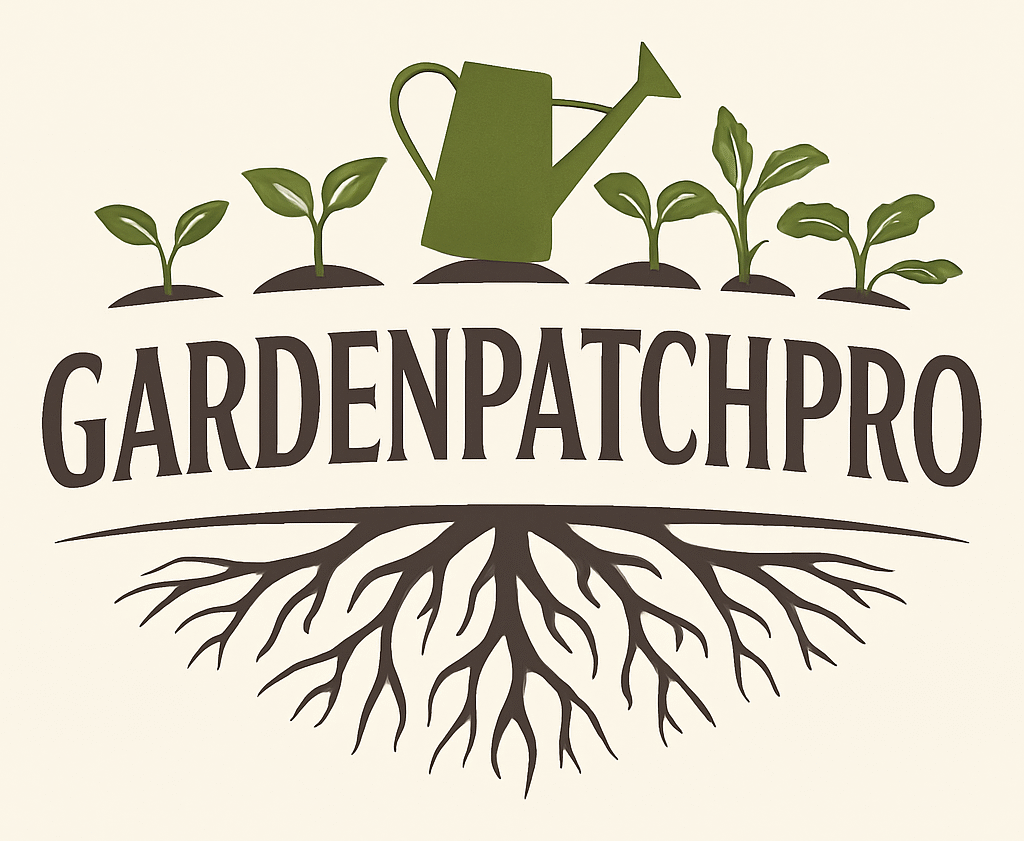11 Bird Feeders Ideas To Attract More Birds To Your Garden
Bird feeders are a simple way to attract birds to outdoor spaces and enjoy watching them up close. Many people choose to add feeders to their yards or gardens to support local wildlife and create a lively atmosphere.
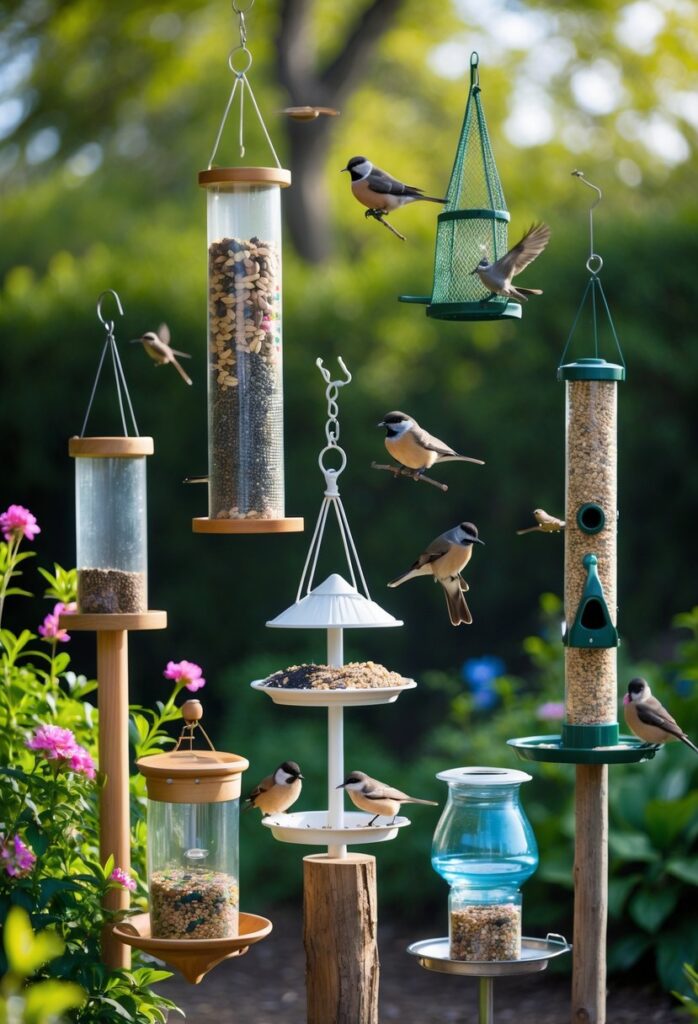
This article shares 11 bird feeder ideas that offer different styles and functions to suit various needs and preferences. These ideas can help anyone find a feeder that fits their space and encourages more birds to visit.
1) Hanging Pinecone Feeder with Peanut Butter

This bird feeder uses a large pinecone with open scales to hold food. Peanut butter acts as a sticky base that helps birdseed stick to the pinecone. This makes it easy for birds to pick seeds while the feeder stays intact.
To make the feeder, spread creamy peanut butter evenly over the pinecone. Then roll or press the pinecone into a bowl of mixed birdseed. Seeds like sunflower, millet, and safflower work well. Finally, tie a sturdy string or twine to the top of the pinecone for hanging.
The feeder can be hung outside from tree branches or hooks. It is natural and biodegradable, making it eco-friendly. It offers an easy way to feed and watch birds during any season, especially winter.
This project requires simple materials and little time. It is safe for most birds and attracts different species to your yard. The peanut butter pinecone feeder is popular because it is affordable and fun to make for people of all ages. For more details, see how to make a hanging pinecone bird feeder with peanut butter.
2) DIY Flower Pot Bird Feeder
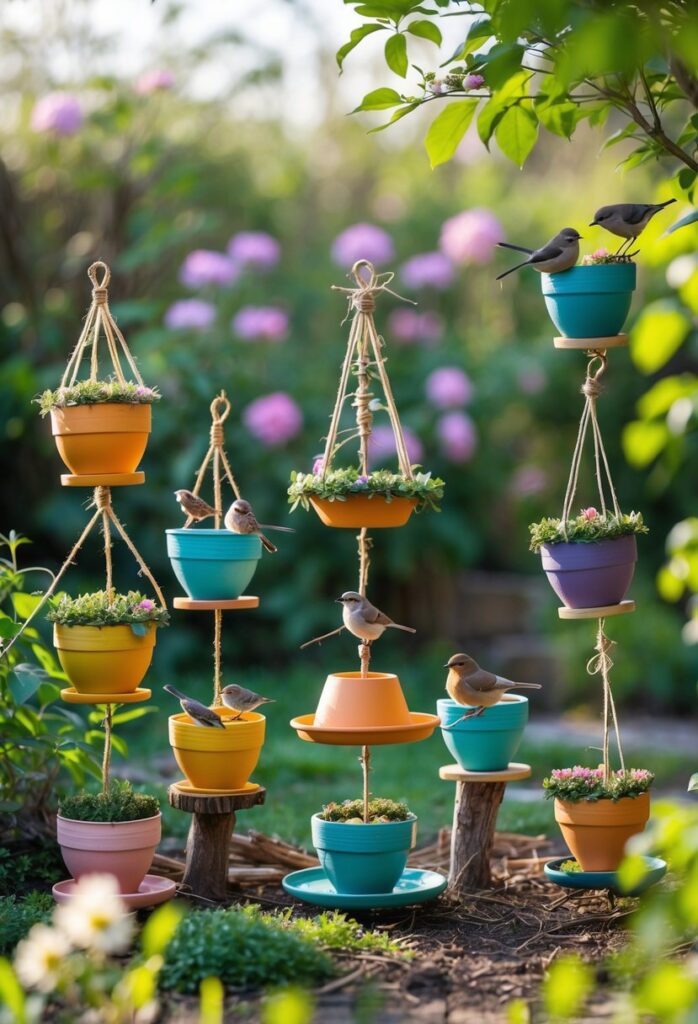
A flower pot bird feeder is a simple and creative way to attract birds. It uses an upside-down flower pot as the main structure. The pot acts as a cover to keep seeds dry while offering nice shelter for birds.
To make one, a saucer is attached at the narrow end of the pot to hold the birdseed. The pot can be painted or left natural to blend into the garden. It can be hung from a tree branch or mounted on a pole.
This design is easy to customize. Adding some drainage holes helps prevent water buildup in the seed area. Using recycled pots and saucers makes this project budget-friendly and eco-friendly.
It works well for small to medium-sized birds. The shape helps protect food from rain and squirrels. More details and ideas on this bird feeder style can be found on the flower pot bird feeder page.
3) Recycled Milk Jug Feeder
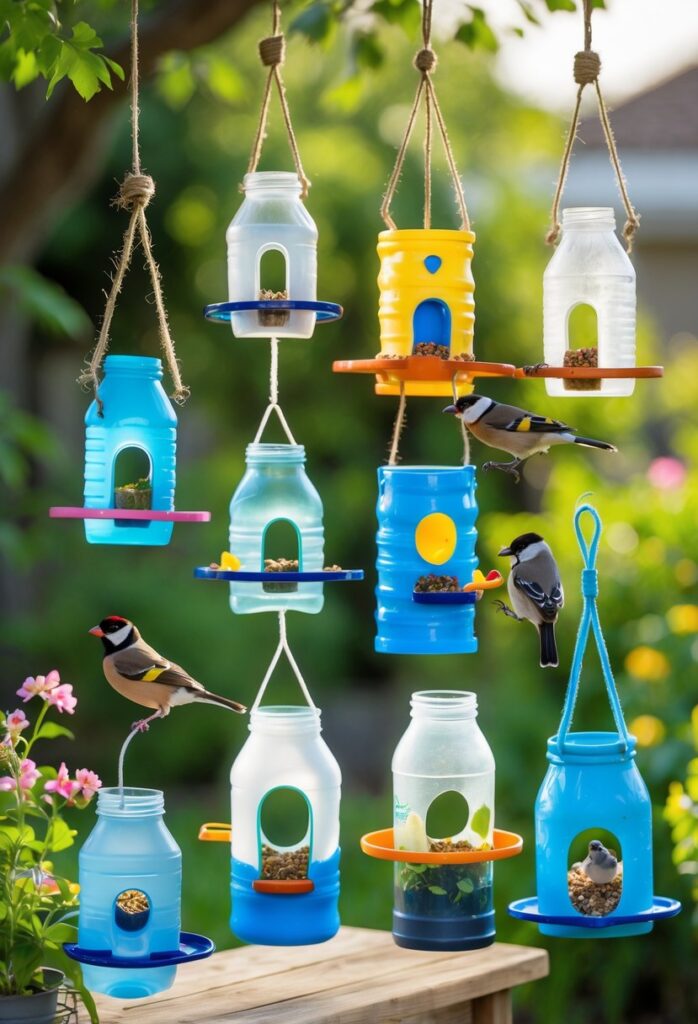
The recycled milk jug feeder is a simple and useful project. It uses an empty plastic milk jug, which can be cut and shaped to hold bird seed. This helps reduce waste while providing birds with food in backyards or gardens.
The feeder can be made by cutting holes on the sides of the jug to create openings for birds. A wooden spoon or small stick can be inserted through the jug to serve as a perch for birds to sit on while feeding.
This type of bird feeder is easy to hang using string or wire through the jug’s handle. It can be decorated with paint or stickers to make it more attractive. Using recycled materials teaches kids about reusing and caring for wildlife.
The milk jug feeder is lightweight, affordable, and effective. It works well for small to medium-sized birds and can be refilled quickly. Instructions and ideas for different designs can be found in guides about milk jug bird feeders.
4) Wooden Platform Feeder

A wooden platform feeder is a simple and classic choice for attracting birds. It provides a flat surface where birds can easily perch and feed. This type of feeder works well for a variety of bird species, including larger songbirds and ground feeders like mourning doves.
The platform should be securely mounted on a post, deck, or fence to keep it stable. It is best placed about six feet above the ground to avoid predators. Some designs include a mesh bottom to keep seeds dry and prevent mold.
Wood is a durable material for feeders, especially if it is treated or sealed for weather resistance. It can also be customized in size and style to fit the yard. Building a wooden platform feeder can be a straightforward project for anyone with basic woodworking skills.
A well-made wooden platform feeder attracts more birds and provides an open, accessible feeding spot. For step-by-step plans and ideas, you can find detailed guides on wooden bird feeders that attract a flock or explore multiple designs for inspiration at DIY platform bird feeder plans.
5) Squirrel-Proof Tube Feeder
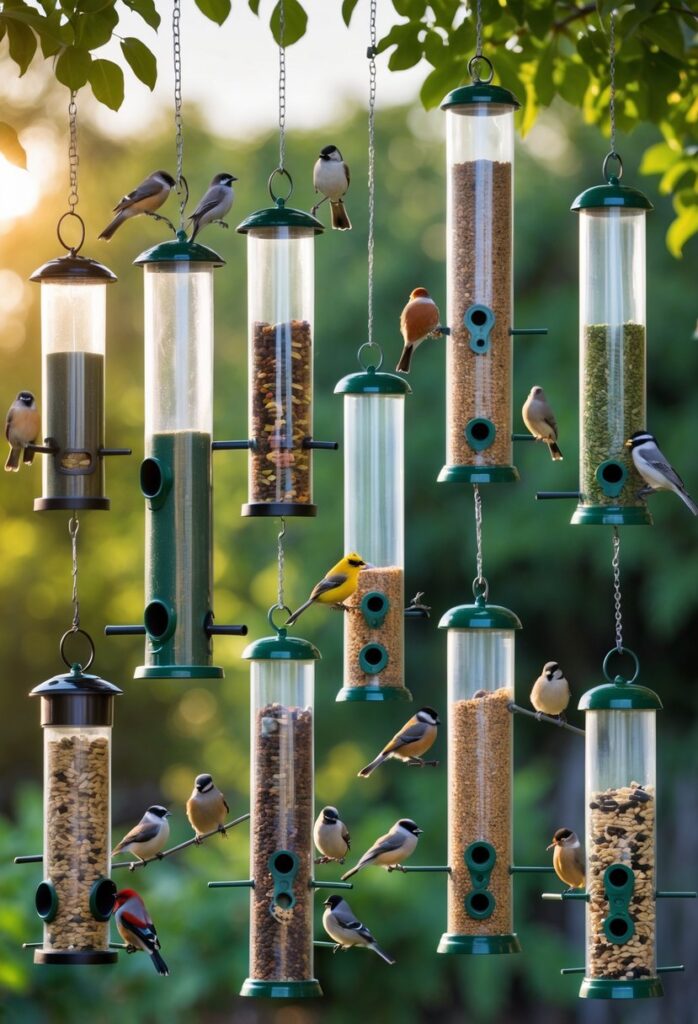
A squirrel-proof tube feeder is designed to keep squirrels from reaching the birdseed. It usually features a long, narrow shape that only small birds can access. This shape helps reduce waste and protects the food.
Many tube feeders use weight-activated mechanisms. When a squirrel climbs on, its weight causes perches to close or seed ports to shut. This stops squirrels from getting the seeds but lets birds feed freely.
Materials like metal and thick plastic make tube feeders more durable. Adding a metal baffle above or below the feeder can also block squirrels from jumping or climbing onto it.
Proper placement helps, too. Hanging the feeder away from trees or structures squirrels can jump from makes it harder for them to reach the feeder.
For those interested in trying a squirrel-proof tube feeder, many effective designs and ideas are available, including DIY options that use common materials. More detailed plans can be found in articles about DIY squirrel-proof bird feeder ideas.
6) Mason Jar Seed Dispenser
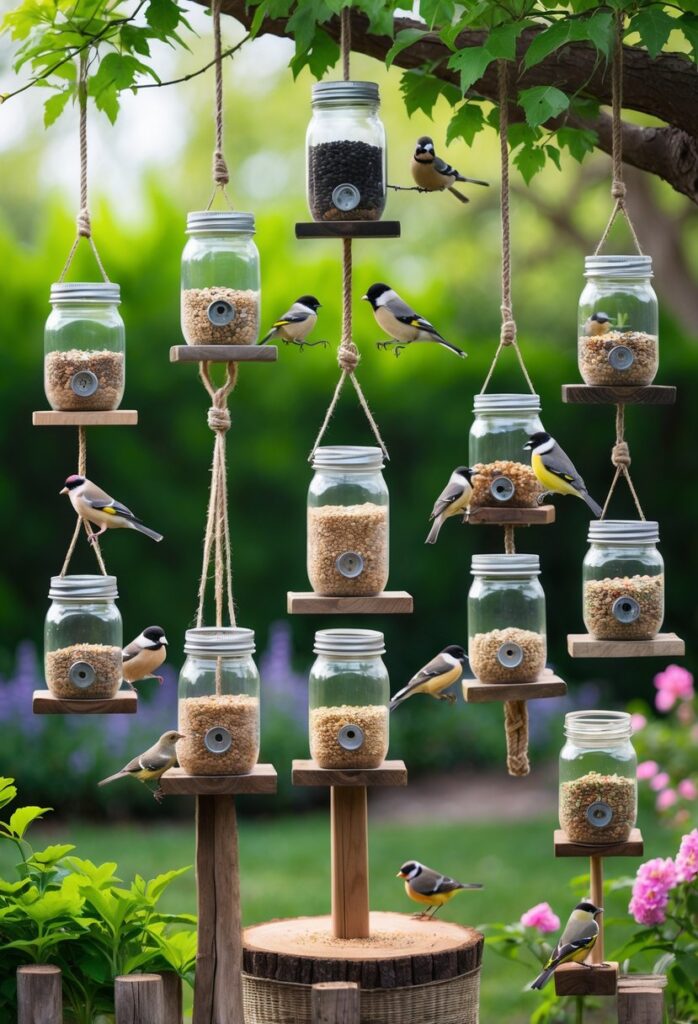
This bird feeder uses a simple Mason jar turned upside down to hold birdseed. The jar is attached to a wooden platform that catches the falling seeds. Birds feed comfortably from the platform while the jar slowly releases seeds.
It is important to fill the jar completely with seeds to avoid air gaps. This helps keep the seeds fresh longer and prevents spills. A well-packed jar ensures that the feeder works smoothly.
The design is easy to make and works well for many backyard birds. It also adds a vintage look through the use of the classic Mason jar. Instructions and ideas for this project can be found in a detailed DIY guide.
Using a Mason jar as a seed dispenser is budget-friendly. It reuses containers many people already have, making it a good option for beginners and experienced bird lovers alike.
7) Teacup and Saucer Bird Feeder
A teacup and saucer bird feeder is a simple, creative way to attract birds. It uses an old teacup and matching saucer to hold birdseed. The teacup is often glued to the saucer, creating a small feeding dish that adds charm to any garden.
This type of feeder is easy to make without special tools. Many versions use waterproof glue and strong string for hanging. It can be placed on a hook or hung from a tree branch. The size is perfect for small birds to perch and feed.
The design also allows for upcycling old or mismatched teacups, making it an eco-friendly project. It can brighten a backyard while providing a gentle outdoor activity. For clear step-by-step instructions, one can find detailed guides to make a teacup bird feeder online.
Using a teacup and saucer as a bird feeder combines function with decorative appeal. The feeder is both practical and a pleasant garden ornament. It encourages birdwatching and helps support local wildlife.
More details on how to create these feeders are available on sites like Hearth and Vine.
8) Hanging Log Feeder
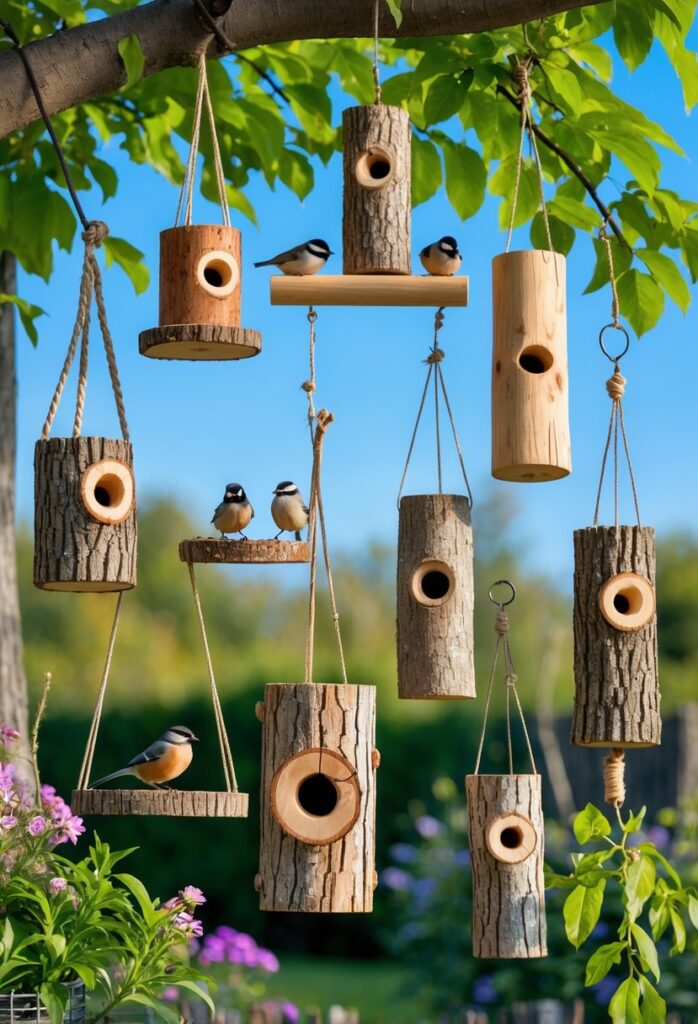
A hanging log feeder is a simple and natural way to attract birds to a garden. It usually uses a hollowed-out log or a section of a fallen tree. The log is filled with birdseed and hung from a sturdy branch or hook.
This type of feeder suits many bird species, including chickadees, woodpeckers, and finches. Its rustic design blends well with outdoor spaces. It also offers a safe feeding spot away from ground predators.
Making a hanging log feeder can be quick and inexpensive. Many use recycled wood or fallen branches. With some drilling and cutting, the log becomes a functional bird feeder.
For best results, it’s important to hang the feeder in a sheltered spot. This protects the seeds from rain and keeps birds comfortable while feeding. It can be positioned near shrubs or trees that provide cover.
More details and ideas on creating this type of feeder can be found in a guide for a homemade log bird feeder.
9) Wine Bottle Bird Feeder

A wine bottle bird feeder is a simple and eco-friendly way to attract birds. It reuses empty bottles by turning them into a container for bird seeds. This feeder can be hung in a garden or on a balcony.
The bottle is usually attached to a wooden or metal base where birds can perch and feed. Birds can access the seeds through small openings near the base. It’s important to make these openings the right size to prevent seeds from spilling out.
Wine bottles add a sleek and attractive look to the feeder. They are also durable and weather-resistant, making them a good choice for outdoor use. Many design ideas allow for easy refilling by removing the bottle.
Creating one can be a fun DIY project. It requires only a few materials and basic tools. For detailed instructions and inspiration, it’s helpful to follow guides like those found in 20 DIY Wine Bottle Bird Feeder Ideas.
10) Bird Feeder Made from a Wooden Crate
A bird feeder made from a wooden crate is a simple and practical option. It uses a crate as the main structure, which makes it easy to create a roomy feeding area.
The open slats in the crate allow birds to perch comfortably while they eat. The wooden material is sturdy and can last long if treated properly.
This type of feeder can be hung or placed on a stand. It provides enough space for multiple birds to feed at once.
To make it weather-resistant, applying a non-toxic sealant is helpful. It also makes cleanup easier and protects the wood from rotting.
Using a wooden crate is a budget-friendly way to build a feeder. Many plans and ideas for making wooden bird feeders like this can be found online, helping beginners get started quickly. For more detailed plans, see this guide to wood bird feeders made from crates and other simple materials.
11) Upcycled Tire Bird Feeder
An upcycled tire bird feeder is a simple way to reuse old tires and attract birds. The tire can be hung or placed on the ground and filled with birdseed.
To create one, the tire is often cleaned and sometimes painted for decoration. Mesh or wood can be added inside to hold the seed and provide perches for birds.
Chains or ropes are used to hang the feeder from a tree or hook. This design is sturdy, weather-resistant, and can hold a good amount of seed.
Birds enjoy coming to these feeders for food, making them a useful addition to any garden. This method turns tires into a helpful and creative bird feeding station.
For more ideas and instructions on making a tire feeder, see this recycled tire bird feeder guide.
Choosing the Best Location for Bird Feeders
The right spot for a bird feeder balances safety for the birds with easy access to food. It also considers weather conditions and how easy it is to reach the feeder for refilling and cleaning.
Safe Placement to Attract Birds
Bird feeders should be placed 5 to 6 feet above the ground. This height keeps many birds safe from predators like cats. It also helps different bird species to feed comfortably.
Position feeders near natural cover like shrubs or trees, but not so close that predators can hide nearby. A distance of about 10 feet is often recommended. This gives birds a quick escape route if needed.
Avoid placing feeders too near busy walkways or areas with loud noise. Birds prefer quiet, calm spots where they feel safe to feed. Choosing a safe location encourages more frequent visits.
Weather Protection and Accessibility
Morning sunlight is ideal for bird feeders. Sunlight helps keep seed dry and prevents mold. It also warms birds in cooler times of the day.
Wind direction matters too. Placing feeders in a spot protected from strong winds reduces seed spillage. It also makes feeding easier for birds.
Access for refilling feeders is important. Placing feeders near where bird food is stored, like a shed or garage, saves time and effort. It also encourages regular cleaning to keep feeders healthy for birds.
A good location balances bird safety, weather protection, and human convenience for the best bird feeding experience. For detailed tips, see advice on where to put a bird feeder.
Seasonal Bird Feeder Maintenance
Proper care keeps bird feeders safe and attractive to birds throughout the year. This includes regular cleaning to stop the spread of disease and adjusting refills to meet the changing needs of birds in different seasons.
Cleaning Tips to Prevent Disease
Clean feeders every two weeks, or weekly during wet weather, to stop mold and bacteria growth. Use a mixture of one part bleach to nine parts water. Soak feeders for 10 minutes, then rinse thoroughly with clean water.
Pay special attention to seed trays, perches, and feeding ports. Remove old or moldy food daily, especially in warm months. Dry the feeders completely before refilling to prevent dampness.
Avoid harsh detergents or hand soaps, which can leave harmful residues. Wearing gloves protects hands from bacteria and cleaning chemicals during this process.
Refilling Strategies for Different Seasons
Adjust feeder contents based on the time of year. In winter, offer high-fat foods like sunflower seeds and suet to help birds maintain energy. Keep feeders full regularly because birds rely on these food sources.
Spring and summer require less seed and more sugar water for hummingbirds. Change sugar water every 2-3 days to prevent fermentation and bacteria.
In fall, gradually shift from summer nectar to seeds and nuts as birds prepare for colder months. Clean and refill feeders more often during heavy bird migration periods to attract a wider variety.
For details on seasonal bird feeder care, visit this page on seasonal backyard bird feeder projects.
Frequently Asked Questions
Many bird feeder designs use everyday items and offer ways to attract different birds while keeping pests away. Choosing strong materials and placing feeders safely helps protect birds and extends feeder life.
What are some creative designs for DIY bird feeders?
Creative feeders include a hanging pinecone coated with peanut butter, a flower pot feeder, and a recycled milk jug feeder. These use simple household items and provide unique feeding spots for birds.
Some feeders are shaped like wooden platforms or use tubes to hold seed, adding variety to backyard bird setups.
Which materials are best for constructing a durable outdoor bird feeder?
Durable feeders often use weather-resistant wood, metal, and strong plastics. Thick plywood or cedar wood resists rot and holds up well outside.
Plastic containers like milk jugs can last if placed in shaded areas. Metal parts help keep feeders sturdy and protect seeds from moisture.
How can one attract a variety of birds to a new feeder?
Offering different seed types like sunflower seeds, millet, and nyjer can draw many bird species. Adding fruit pieces or suet caters to birds that prefer soft foods.
Placing feeders near shrubs or trees gives birds cover and makes them feel safe while feeding.
What safety considerations should be taken into account when placing bird feeders?
Feeders should hang at least five feet above ground to reduce predator risks. Avoid locations near windows to prevent bird collisions.
Regularly cleaning feeders prevents disease and keeps birds healthy. Securely hanging feeders prevents accidents from wind or animals.
Are there any bird feeder designs that also deter squirrels and other pests?
Tube feeders with small ports limit access to seeds for squirrels. Squirrel-proof feeders often include weight-sensitive perches that close the seed opening under heavy weight.
Using baffles above or below feeders helps block climbing squirrels from reaching food.
Which foods should be avoided in bird feeders to ensure the health of the birds?
Birds should not eat salted, spicy, or moldy foods. Bread and junk food lack nutrients and can harm birds.
Avoid feeding birds raw beans, avocado, or chocolate, as these are toxic to many species. Fresh seeds and nuts are safer choices.
